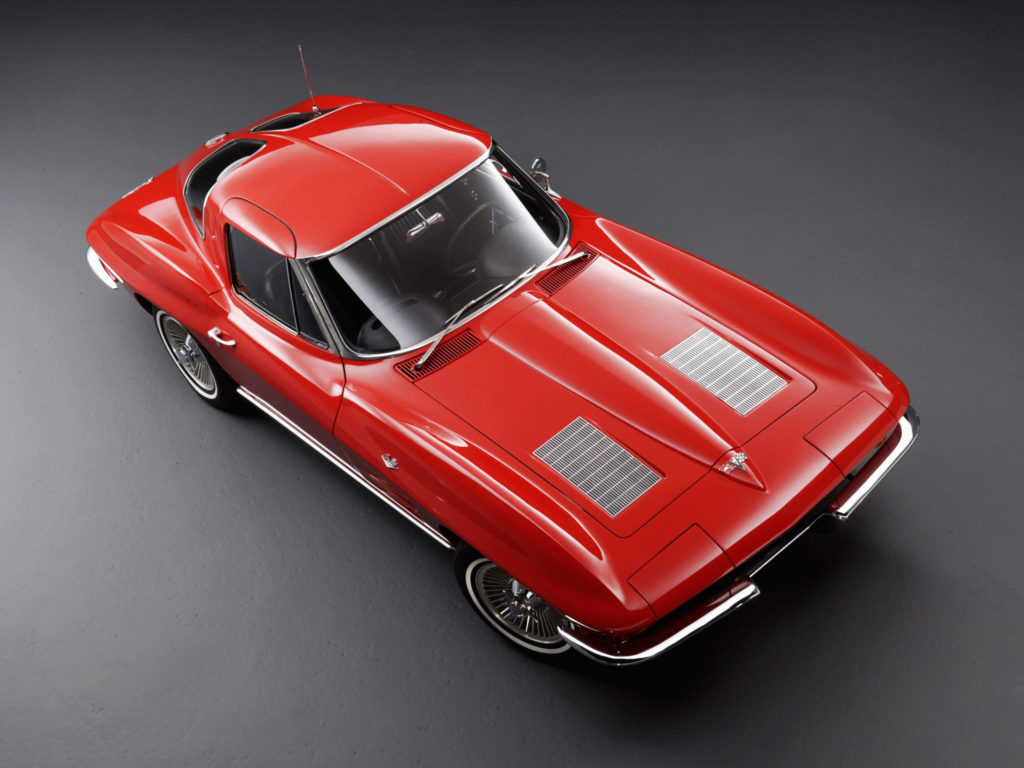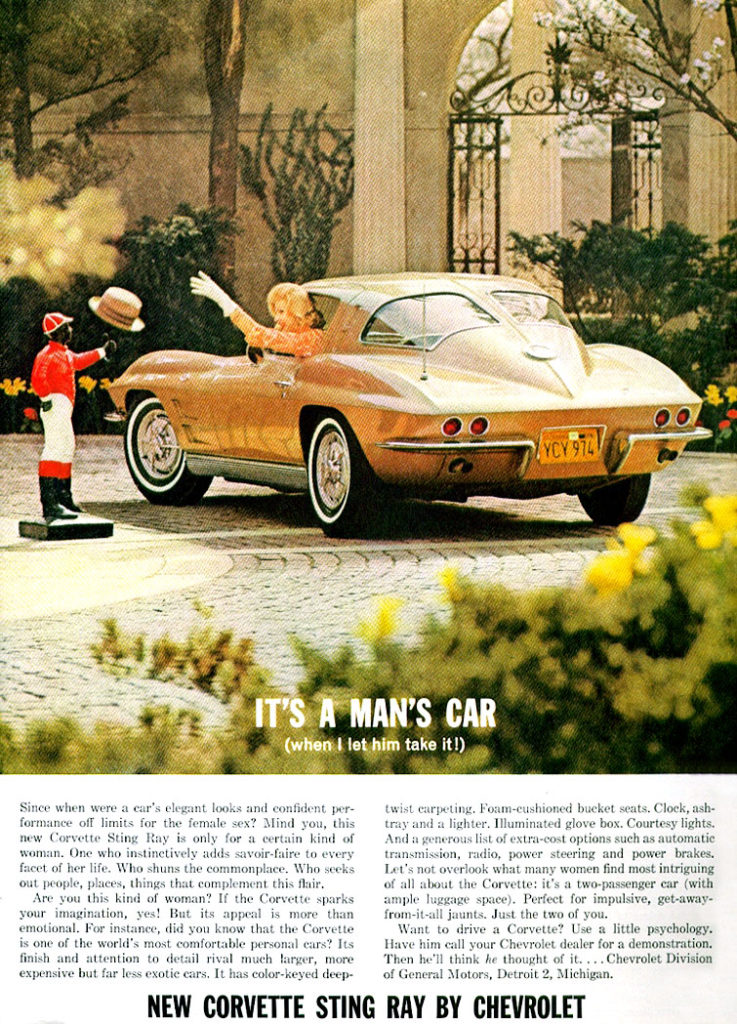
The 1963 Sting Ray production car’s lineage can be traced to two separate GM projects: the Q-Corvette, and perhaps more directly, Mitchell’s racing Sting Ray. The Q-Corvette, initiated in 1957, envisioned a smaller, more advanced Corvette as a coupe-only model, boasting a rear transaxle, independent rear suspension, and four-wheel disc brakes, with the rear brakes mounted inboard. Exterior styling was purposeful, with peaked fenders, a long nose, and a short, bobbed tail.
Meanwhile, Zora Arkus-Duntov and other GM engineers had become fascinated with mid and rear-engine designs. It was during the Corvair’s development that Duntov took the mid/rear-engine layout to its limits in the CERV I concept. The Chevrolet Experimental Research Vehicle was a lightweight, open-wheel single-seat racer. A rear-engined Corvette was briefly considered during 1958-60, progressing as far as a full-scale mock-up designed around the Corvair’s entire rear-mounted power package, including its complicated air-cooled flat-six as an alternative to the Corvette’s usual water-cooled V-8. By the fall of 1959, elements of the Q-Corvette and the Sting Ray Special racer would be incorporated into experimental project XP-720, which was the design program that led directly to the production 1963 Corvette Sting Ray. The XP-720 sought to deliver improved passenger accommodation, more luggage space, and superior ride and handling over previous Corvettes.
The 1963 Corvette Sting Ray not only had a new design, but also newfound handling prowess. The Sting Ray was also a somewhat lighter Corvette, so acceleration improved despite unchanged horsepower. For the 1963 model year, 21,513 units would be built, which was up 50 percent from the record-setting 1962 version. Production was divided almost evenly between the convertible and the new coupe – 10,919 and 10,594, respectively – and more than half the convertibles were ordered with the optional lift-off hardtop. Nevertheless, the coupe wouldn’t sell as well again throughout the Sting Ray years. In fact, not until 1969 (by which time the coupe came with removable T-tops) did the closed Corvette sell better than the open one.
Pricing:
Coupe: $4037
Engine options:
327 in Small-Block V8 – 250 HP
327 in Small-Block V8 – 300 HP
327 in Small-Block FI V8 – 360 HP
Units produced: 21,513: 10,919 convertible and 10,594 coupe
Top Speed: 142.5 mph
Highlights of This Year:
The Corvette Sting Ray evolved from a racing car called the Mitchell Sting Ray. William L. Mitchell had replaced Harley Earl as head of General Motors styling in 1958. Mitchell thought it was important for the Corvette to be associated with racing, so he persuaded Chevrolet general manager Ed Cole to sell him the chassis of the 1957 Corvette SS “mule” for $1 (to get around the corporate racing ban) so he could build a race car. Mitchell had designer Larry Shinoda create a body for the Sting Ray race car inspired by the sea creature of the same name. Shinoda came up with the “split-window” coupe design which Mitchell loved although Zora Arkus-Duntov was against its vision-blocking look. The “split-window” was offered only one year and has become a very collectible item. Corvette “firsts” for 1963 included optional knock-off wheels, air conditioning, and leather upholstery. Air conditioning was a rare option in 1963 because it was introduced late in the year. Only 1.3 percent of the 1963 Corvettes were so equipped. However 83.5 percent came with four-speed manual transmission. The 184-powered Corvette could go from 0-to-60 mph in 5.9 seconds and from 0-to-100 mph in 16.5 seconds. Five historic Corvette Grand Sports were constructed in 1963 before all GM racing programs were canceled. Grand Sports weighed 1,908 pounds and had a 377-cd version of the small-block Chevy V-8 equipped with an aluminum cylinder block and aluminum hemi-head cylinder heads. They also featured a twin ignition system and port fuel injection.
Photos of the 1963 Corvette:



The Story behind the (first) Corvette Z06:
Let’s flashback to the summer of 1955 at Le Mans, France. Twenty-three hours and fifteen minutes into the world’s most brutal and mechanically challenging endurance race, after a near day of non-stop racing, disaster struck: 83 spectators died, 120 cheering fans severely injured. Motorsport from then on was never the same.
Reeling with the aftermath of such a tragic accident, automakers across the globe were compelled to shut down racing operations for a while in fear and expectation of the worst. Two years later, the American Manufacturers Association placed a formal ban on manufacturer-backed racing programs in an attempt to limit the damage racing may have caused in the previous years.
While a noble effort, the ban was not to be upheld long—while all the major automakers did indeed refrain from racing their own official racecars, the guy on the street could easily outfit his or her vehicle of choice with homologated parts and specs capable of racing in many premier series throughout the world.
In a reactionary measure from the masterminds behind the Corvette, a legend was born: the 1963 Corvette Z06. Even through the restrictions, the men and women from Chevrolet kept pushing the research and development of their iconic sports-car, producing an automobile ready to race straight from the factory.
The Z06 was released to the public during the debut of the ’63 split-window Corvette, allowing enthusiasts track-ready enjoyment and impeccable style immediately after purchase. With the exclusive Z06 package came the arrival of many racing-derived parts such as massive cooled disc brakes, heavy-duty suspension and, in traditional motorsport fashion, a gargantuan 36.5 gallon fuel tank.
But of course, the masterpiece would not be complete without the absolutely phenomenal 327 small-block V8. Producing 360 hp and 352 lbs-ft. of torque, the Z06 hit 60 MPH in an impressive 5.9 seconds, giving drivers instantly competitive performance the moment they turned the key.
Truth be told though, the racing-spec Corvette was far from cheap, debuting with a base price nearly $800 dollars more than the mighty Jaguar E-Type. Likely due to the racing nature of the car and GM’s willingness to eschew sanctioned racing, the Z06 option was not even listed in the brochures. In the end, a total of 199 Z06-optioned Corvettes were produced, making the ’63 one very rare machine.
After a 38-year hiatus, the Z06 option returned to the Corvette line-up, continuing the rip-roaring performance from 40 years prior but now with the driver-friendly practicality that technology allowed. Now that the world readies itself for Corvette’s latest track rocket, one can truly appreciate the epic history of the absolutely Corvette Z06.
Sources
http://gmauthority.com/blog/2014/03/the-story-behind-the-1963-chevrolet-corvette-z06/
https://en.wikipedia.org/wiki/Chevrolet_Corvette_(C2)
http://www.motorera.com/corvette/1960/vet63.htm
https://www.supercars.net/blog/1963-chevrolet-corvette-sting-ray-split-window/
Author
Kent Clapsaddle // Contributor
